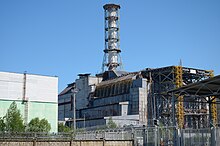ゾウの足
ゾウの足(ぞうのあし、英: Elephant's Foot)は、1986年4月のチェルノブイリ原子力発電所事故中に生成された巨大な炉心溶融物のかたまりの通称[1]。「ゾウの足」は事故発生から約8カ月後の1986年12月、溶融した4号炉炉心の直下に位置する蒸気分配回廊上で発見された。現在でも強い放射能を保っているが、放射性崩壊が進んだことで当初よりも危険性は減少している。密度と硬度は非常に高く、ドリルを受け付けないほどであったため、サンプルを採取するためにカラシニコフ銃が使用された[2][3]。
概要[編集]
「ゾウの足」はチェルノブイリ原子力発電所事故の結果として形成された巨大な炉心溶融物のかたまりであり、事故発生から約8カ月が経過した1986年12月に初めて発見された。この物体は何層にも折り重なった樹皮のような構造を持ち、黒鉛を含むため黒みがかった色をしている[4][5]。
「ゾウの足」という通称は、その皺の多い見た目が動物のゾウの足に似ていたことに由来する。「ゾウの足」はチェルノブイリ原子力発電所4号炉炉心の直下の地上6メートルに位置する蒸気分配回廊上に存在している[6][7]。
性質[編集]
サンプル調査の結果、「ゾウの足」は主に全体の70-90%が二酸化ケイ素から成り、核燃料を2-10%の割合で含んでいることが判明した[4]。二酸化ケイ素とウラン以外の構成物として、チタン、マグネシウム、ジルコニウム、グラファイト(黒鉛)等が含まれている[4][8][9][10]。
物質としての密度は非常に高く、遠隔操作ロボットに搭載されていたサンプル採取用のドリルを受け付けないほど硬かったため、最終的に狙撃手が現場に呼ばれ、カラシニコフ銃で遠くから射撃することで一部を破壊し、成分調査のためのサンプルを回収した[8][4][5]。1998年6月の時点で、「ゾウの足」は部分的にひび割れ、表面はぼろぼろに崩れ始めていた[5][11]。
危険性[編集]
1986年12月の発見時、「ゾウの足」周辺の放射線量は約8,000レントゲン毎時(80グレイ毎時)であり[4]、5分程度の被曝でヒトの半数致死線量 (4.5グレイ) に達する値だった[4][12]。この物体が発する放射線量は放射性崩壊によって時とともに減少しており、1996年には原子炉封印プロジェクトの副長アルトゥール・コルネイエフ (Artur Korneyev) が「ゾウの足」を実際に訪れ、自動撮影カメラとフラッシュライトを駆使して何枚かの写真を撮影した[13][注釈 1]。
「ゾウの足」は現在の場所に到達するまでに少なくとも2メートルの厚さのコンクリートを貫通してきており[5]、もし貫通を続ければ最終的には地下水に達し、地域の飲み水を汚染するのではという懸念が存在した[15]。しかしながら、2016年時点でこの物体は当初の位置からほとんど移動しておらず、温度も周囲の環境に比べて(進行中の放射性崩壊によって)わずかに高い程度であると推定されている[13]。
脚注[編集]
注釈[編集]
- ^ コルネイエフはこの訪問から十数年が経過した後も健在であり、引退を前にした2014年にはニューヨークタイムズの記者ヘンリー・ファウンテンのインタビューに答えている[14]。
出典[編集]
- ^ “〈過去〉チェルノブイリ原発事故で溶け落ちた燃料。通称「ゾウの足」=アレクサンドル・ボロウォイ博士提供”. 朝日新聞デジタル. 2019年8月4日閲覧。
- ^ Higginbotham, Adam (2019). Midnight in Chernobyl: The Untold Story of the World's Greatest Nuclear Disaster. Random House. ISBN 9781473540828 p.340 "The substance proved too hard for a drill mounted on a motorized trolley, ... Finally, a police marksman arrived and shot a fragment of the surface away with a rifle. The sample revealed that the Elephant's Foot was a solidified mass of silicon dioxide, titanium, zirconium, magnesium, and uranium ..."
- ^ Mould, Richard F. (Richard Francis) (2000). Chernobyl record : the definitive history of the Chernobyl catastrophe. Bristol, UK: Institute of Physics Publishing. pp. 130. ISBN 075030670X. OCLC 43952057
- ^ a b c d e f United States Foreign Broadcast Information Service, ed (1989). Daily Report: Soviet Union. The Service. p. 133. "The radiation level near it was approximately 8,000 roentgens per hour in 1986. Even five minutes spent near the “foot” would have killed a man ... the substance failed to yield to a drill mounted on a special remote-control truck ... Analysis of the fragments obtained in this way showed that they consisted of 70-90% silicon dioxide (fused sand), 2-10% fuel particles, and, in addition, contained graphite (hence the black color), metal alloys, and so on ..."
- ^ a b c d R. F. Mould (2000). Chernobyl Record: The Definitive History of the Chernobyl Catastrophe. CRC Press. p. 130. ISBN 9781420034622. "It has many layers, like the bark of a tree, and pieces of this bark can be removed by the bullets of a Kalashnikov rifle. This sounds like a very archaic way of obtaining samples for analysis to determine parameters ..."
- ^ Higginbotham 2019, p. 285, 340.
- ^ Hill, Kyle (4 December 2013). “Chernobyl's Hot Mess, 'the Elephant's Foot', Is Still Lethal”. Nautilus. ISSN 2372-1766 2018年11月8日閲覧。.
- ^ a b Higginbotham 2019, p. 340.
- ^ Jaromir Kolejka, ed (2002). Role of GIS in Lifting the Cloud Off Chernobyl. NATO Science: Earth and environmental sciences. 10 (illustrated ed.). Springer Science & Business Media. p. 72. ISBN 9781402007682
- ^ Ann Larabee (2000). Decade of Disaster (illustrated ed.). University of Illinois Press. p. 50. ISBN 9780252068201
- ^ Vlasova, Irina; Shiryaev, Andrey; Ogorodnikov, Boris; Burakov, Boris; Dolgopolova, Ekaterina; Senin, Roman; Averin, Alexey; Zubavichus, Yan et al. (2015). “Radioactivity distribution in fuel-containing materials (Chernobyl "lava") and aerosols from the Chernobyl "Shelter"”. Radiation Measurements 83: 20–25. doi:10.1016/j.radmeas.2015.06.005. ISSN 1350-4487.
- ^ “Lethal Dose (LD)”. US Nuclear Regulatory Commission (2019年3月21日). 2019年3月21日閲覧。
- ^ a b Goldenberg, Daniel (2016年1月24日). “The Famous Photo of Chernobyl’s Most Dangerous Radioactive Material Was a Selfie”. Atlas Obscura. 2019年3月21日閲覧。
- ^ Fountain, Henry; Daniels, William (2014年4月27日). “Chernobyl: Capping a Catastrophe”. New York Times 2019年3月21日閲覧。
- ^ “There is a Radioactive Elephant’s Foot Slowly Burning a Hole in the Ground”. Office for Science and Society, McGill University (2018年3月22日). 2019年3月7日時点のオリジナルよりアーカイブ。2019年3月7日閲覧。

